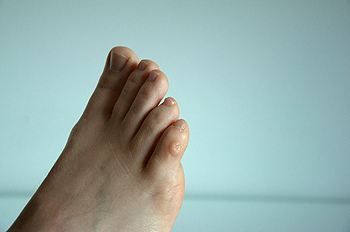 Hammertoe is a common foot deformity in which the toes bend downward at the middle joint, creating a hammer-like shape. This deformity typically affects the second, third, or fourth toes and causes pain, discomfort, and joint stiffness. There are many reasons why a hammertoe may develop. Chronically wearing ill-fitting shoes which are too tight, narrow, have excessively high heels, or squeeze your toes together, can contribute to the formation of hammertoes. Hereditary foot differences, having unusually long toe bones, weakness in the muscles of the feet, or injuries can also make hammertoes more likely. Other foot conditions, including bunions and rheumatoid arthritis, may increase your risk of hammertoes. If you notice that your toes are changing in appearance, or if you are experiencing any foot pain, please seek the care of a podiatrist. Treating hammertoes early can help stop or slow their progression.
Hammertoe is a common foot deformity in which the toes bend downward at the middle joint, creating a hammer-like shape. This deformity typically affects the second, third, or fourth toes and causes pain, discomfort, and joint stiffness. There are many reasons why a hammertoe may develop. Chronically wearing ill-fitting shoes which are too tight, narrow, have excessively high heels, or squeeze your toes together, can contribute to the formation of hammertoes. Hereditary foot differences, having unusually long toe bones, weakness in the muscles of the feet, or injuries can also make hammertoes more likely. Other foot conditions, including bunions and rheumatoid arthritis, may increase your risk of hammertoes. If you notice that your toes are changing in appearance, or if you are experiencing any foot pain, please seek the care of a podiatrist. Treating hammertoes early can help stop or slow their progression.
Hammertoes can be a painful condition to live with. For more information, contact one of our podiatrists of Illinois . Our doctors will answer any of your foot- and ankle-related questions.
Hammertoe
Hammertoe is a foot deformity that occurs due to an imbalance in the muscles, tendons, or ligaments that normally hold the toe straight. It can be caused by the type of shoes you wear, your foot structure, trauma, and certain disease processes.
Symptoms
- Painful and/or difficult toe movement
- Swelling
- Joint stiffness
- Calluses/Corns
- Physical deformity
Risk Factors
- Age – The risk of hammertoe increases with age
- Sex – Women are more likely to have hammertoe compared to men
- Toe Length – You are more likely to develop hammertoe if your second toe is longer than your big toe
- Certain Diseases – Arthritis and diabetes may make you more likely to develop hammertoe
Treatment
If you have hammertoe, you should change into a more comfortable shoe that provides enough room for your toes. Exercises such as picking up marbles may strengthen and stretch your toe muscles. Nevertheless, it is important to seek assistance from a podiatrist in order to determine the severity of your hammertoe and see which treatment option will work best for you.
If you have any questions, please feel free to contact our offices located in Wheeling and Berwyn, IL . We offer the newest diagnostic and treatment technologies for all your foot care needs.





